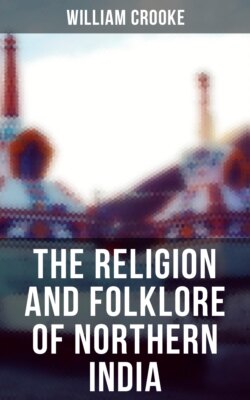Читать книгу The Religion and Folklore of Northern India - William Crooke - Страница 69
На сайте Литреса книга снята с продажи.
The Worship of the Great Mothers.
ОглавлениеTable of Contents
From these generally benevolent village godlings we pass on to a very obscure form of local worship, that of the Great Mothers. It prevails both in Aryan and Semetic lands,53 and there can be very little doubt that it is founded on some of the very earliest beliefs of the human race. No great religion is without its deified woman, the Virgin, Mâyâ, Râdhâ, Fâtimah, and it has been suggested that the cultus has come down from a time before the present organization of the family came into existence, and when descent through the mother was the only recognized form.54
We have already met instances of this mother-worship in the case of Gangâ Mâî, “Mother Ganges,” and Dhartî Mâtâ, “the Earth Mother.” We shall meet it again in Sîtalâ Mâtâ, “the small-pox Mother.”
In the old mythology Aditî, or infinite space, was regarded as the Eternal Mother, and Prâkritî was the Eternal Mother, capable of evolving all created things out of herself, but never so creating unless united with the eternal spirit principle embodied in the Eternal Male, Parusha. There appears to have been a tendency on the part of the Indo-Germanic race to look upon their deities as belonging to both sexes at once, and hence the dualistic idea in Brâhmanism of Ardhanari, or the androgynous Siva.55
We shall meet later on with the ghost of the unpurified mother, the Churel, which is based on a different but cognate association of ideas. Akin to this, again, is the worship of the Satî, or model wife, to which we shall refer again, and that of the Châran women of Gujarât, who were obliged to immolate themselves to prevent outrage from the Kolis and other freebooters.
This worship, probably derived from one of the so-called non-Aryan races, was subsequently developed into that of the female energies of the greater gods, a Brâhmânî of Brahma, Indrânî of Indra, and so on; and thus the simple worship of the mother has developed and degenerated into the abominations of the Tantras. These mothers are usually regarded as eight in number, the Ashta Mâtrî, but the enumeration of them varies. Sometimes there are only seven—Brâhmî or Brâhmânî, Maheshvarî, Kaumârî, Vaishnavî, Vârâhî, Indrânî or Aindrânî, or Mahendrî and Châmundâ. Sometimes the number is nine—Brâhmânî, Vaishnavî, Raudrî, Vârâhî, Narasinhikâ, Kaumârî, Mahendrî, Châmundâ, Chandikâ. Sometimes sixteen—Gaurî, Padmâ, Sachî, Medhâ, Savitrî, Vijayâ, Jayâ, Devasenâ, Svadhâ, Svâhâ, Sântî, Pushtî, Dhritî, Tushtî, Atmadevatâ, Kuladevatâ.56 They are closely connected with the worship of Siva and are attendants on his son Skanda, or Kârttikeya, and rise in the later mythology to a much greater number.
